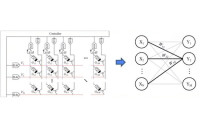Power Bottleneck: How RRAM Redefines Calculation

From Von Neumann to RRAM,the Hardware Revolution for Energy-reduced AI
The Enduring Challenge of the Von Neumann Architecture
For decades, modern computers, including high-performance CPUs and microcontrollers, have been based on the Von Neumann architecture. This structure separates the Central Processing Unit (CPU) from the memory unit. Its primary advantage is flexibility, allowing processing problems to be solved with relative ease through software programming.
However, this design suffers from a critical drawback: the Von Neumann Bottleneck.
- Processing requires constantly moving data from the memory to the CPU, performing a calculation, and then transferring the results back to the memory.
- This intensive data transport, costs time and, crucially, consumes an enormous amount of energy. In high-speed, data-intensive workloads like Artificial Intelligence (AI), this movement alone can account for an estimated 80% to 90% of the total chip power consumption.
Current AI accelerators, such as those made by Nvidia, rely on massive arrays of transistors and digital processing (synchronous operation), leading to immense power demands and heat generation. To sustain the growth of AI, especially for applications on small, constrained edge devices, alternatives are urgently needed.
In-Memory Computing: The Digital Precursors
One approach to mitigate the data bottleneck is In-Memory Computing (IMC), also known as Compute-in-Memory (CIM), where computation is performed closer to the data.
This concept is not entirely new. Architectures like ASICs (Application-Specific Integrated Circuits) and FPGAs (Field-Programmable Gate Arrays) move the processing units closer to the memory and are designed to solve a dedicated computing task (e.g., a FIR filter).
- Advantages: They offer significantly higher processing speed and lower power consumption compared to a general-purpose CPU.
- Drawbacks: They sacrifice the flexibility of software for a fixed, hardware-defined structure, requiring time-consuming redesigns for new tasks. Furthermore, most of these digital solutions still rely on synchronous processing (using a fixed clock cycle for all operations), which, while easier to design, limits the maximum attainable speed.
The RRAM Revolution: Analog Computing Reborn
The most disruptive approach to IMC is leveraging emerging non-volatile memory technologies, such as the Memristor (Memory Resistor), particularly in the form of Resistive Random-Access Memory (RRAM).
Unlike traditional digital memory cells (like FlipFlops, SRAM, or DRAM) that store information as separate bits (0 or 1) using complex transistor circuits, a single RRAM cell stores a value as a continuously adjustable resistance or conductance.
This analog storage method is perfectly suited for implementing the core function of a Neural Network: the Vector-Matrix Multiplication (VMM).
How RRAM Enables Analog AI:
- The Crossbar Array: RRAM cells are arranged in an ultra-dense crossbar array (often in a 1T1R – one transistor, one resistor – configuration).
- Mapping the Network: The synaptic weights of the neural network are directly mapped onto the analog conductance of the individual RRAM cells.
- Instant Calculation: By applying an input voltage vector (data) across the rows, the array intrinsically performs the multiplication (Voltage × Conductance = Current) and summation (Kirchhoff’s current law) simultaneously and analogously.
This eliminates the need for repeated digital data transfer and complex digital logic. The result is a chip that can perform massive parallel calculations at a fraction of the energy required by current digital synchronous processors.
The Future of Processing: Beyond Bits
RRAM-based analog IMC represents a major leap toward truly energy-efficient AI. While still facing challenges related to device variability and manufacturing precision, the potential power savings and speed improvements are immense.
This technology is one of several promising avenues being explored to bypass the digital power wall, alongside other advanced fields like Quantum Computing and Photonic In-Memory Computing (using light beams). RRAM, however, offers a path to integrate energy-efficient analog computation directly onto modern semiconductor platforms.



Discussion (0 commentaire(s))